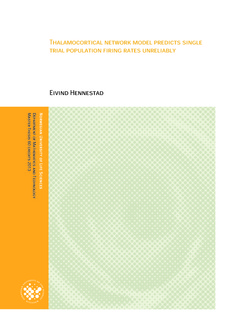Thalamocortical network model predicts single trial population firing rates unreliably
Master thesis
Permanent lenke
http://hdl.handle.net/11250/189041Utgivelsesdato
2014-02-14Metadata
Vis full innførselSamlinger
- Master's theses (RealTek) [1722]
Sammendrag
Multielectrodes provide a powerful tool for exploring neuronal networks, but interpreting the recorded data in terms of network dynamics is difficult. Two novel modeling schemes have attempted to solve this problem, namely laminar population analysis (LPA) and the thalamocortical network model. LPA describes how to extract population firing rates from multielectrode recordings and the thalamocortical network model is estimated from these population firing rates. While these modeling methods have been successfully applied to trial-averaged data recorded from the thalamocortical loop in the rat barrel system, it is unknown whether they also work on single trial data.
This thesis aims to evaluate the thalamocortical model on single trial data. First, to learn more about the thalamocortical model, we tested it with simple input functions. Second, we looked for patterns in the single trial variability. Third, we used single trial thalamic firing rates as input in the thalamocortical model and compared the model response with cortical layer 4 population firing rates identified using results from LPA on single trial data.
We found that the thalamocortical model is unstable for large inputs. Single trial variability is large: response magnitudes typically range from two times smaller to two times larger than trial-averaged responses. Consequently, for the largest single trial inputs the model blows up. On a more general basis, the model also does not predict responses reliably due to high single trial variability in both thalamus and cortex.
In conclusion, features of the recorded activity are hidden away in trial averages, and the results demonstrate that there are many unknowns not being explained by the thalamocortical model. More effort should be put into understanding how neuronal networks handle activity in real time.
